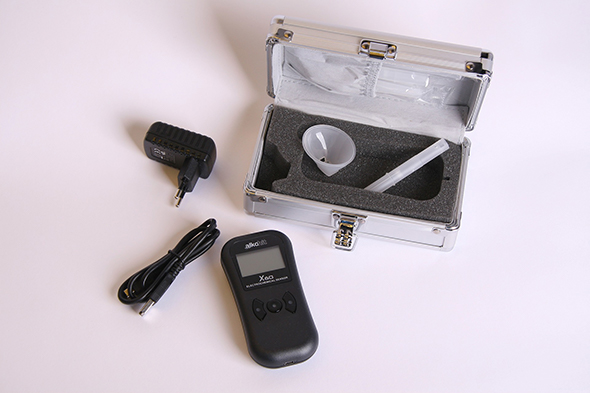Israeli researchers optimistic about COVID-19 breathalyser test

Cheryl Guttman Krader
Published: Friday, May 29, 2020
 Image by piotrpiotrwojcicki from Pixabay[/caption]
TeraGroup, an Israeli company, is working with the Israeli Ministry of Defense Administration for the Development of Weapons and Technological Infrastructure (MAFAT) to develop a breathalyser test for COVID-19. In a recent television news segment, researchers involved in the project reported that they are making promising progress.
The technology uses terahertz frequencies and generates a result within 60 seconds. Individuals perform the test by taking a deep breath and then exhaling into a tube three times. Presence of the coronavirus within the exhaled breath aerosols is determined based on recognition of its spectral signature.
In addition to its benefits for providing an immediate result and avoiding any laboratory processing, the test has the advantage of eliminating the need for both a skilled individual to obtain the sample and swabs, which have been in limited supply in some areas.
According to one of the researchers, the breathalyser test may also detect the virus within the first four days after initial exposure, which is a window of time when results from polymerase chain reaction testing may be inaccurate.
The developers believe that by identifying people who are not carrying the SARS-CoV-2 virus that causes COVID-19, the test will allow workers to return to their jobs and thereby assist in mobilising the economy. They describe the breathalyser test as “the new thermometer”.
Amir Tirosh MD, PhD, Director of the Endocrine Institute, Sheba Medical Center, Ramat Gan, Israel, said that this project can change how the world copes with the COVID-19 pandemic.
“If we are debating whether to open the economy, how much to open, and how safe will it be, this changes the rules of the game,” said Dr Tirosh.
The terahertz technology was being used for gender detection in avian eggs. It became the focus for developing a diagnostic test for COVID-19 within just a few days after government leaders and representatives from MAFAT decided to begin thinking outside of the box to come up with ideas for fighting the pandemic, including by looking at the potential of technologies that were already available on the market.
The performance of the breathalyser test is being investigated at the Magen David Adom drive-through testing site in Jerusalem. Individuals who arrived for a traditional swab test at that centre were first asked to blow into the breathalyser’s collection tube.
Image by piotrpiotrwojcicki from Pixabay[/caption]
TeraGroup, an Israeli company, is working with the Israeli Ministry of Defense Administration for the Development of Weapons and Technological Infrastructure (MAFAT) to develop a breathalyser test for COVID-19. In a recent television news segment, researchers involved in the project reported that they are making promising progress.
The technology uses terahertz frequencies and generates a result within 60 seconds. Individuals perform the test by taking a deep breath and then exhaling into a tube three times. Presence of the coronavirus within the exhaled breath aerosols is determined based on recognition of its spectral signature.
In addition to its benefits for providing an immediate result and avoiding any laboratory processing, the test has the advantage of eliminating the need for both a skilled individual to obtain the sample and swabs, which have been in limited supply in some areas.
According to one of the researchers, the breathalyser test may also detect the virus within the first four days after initial exposure, which is a window of time when results from polymerase chain reaction testing may be inaccurate.
The developers believe that by identifying people who are not carrying the SARS-CoV-2 virus that causes COVID-19, the test will allow workers to return to their jobs and thereby assist in mobilising the economy. They describe the breathalyser test as “the new thermometer”.
Amir Tirosh MD, PhD, Director of the Endocrine Institute, Sheba Medical Center, Ramat Gan, Israel, said that this project can change how the world copes with the COVID-19 pandemic.
“If we are debating whether to open the economy, how much to open, and how safe will it be, this changes the rules of the game,” said Dr Tirosh.
The terahertz technology was being used for gender detection in avian eggs. It became the focus for developing a diagnostic test for COVID-19 within just a few days after government leaders and representatives from MAFAT decided to begin thinking outside of the box to come up with ideas for fighting the pandemic, including by looking at the potential of technologies that were already available on the market.
The performance of the breathalyser test is being investigated at the Magen David Adom drive-through testing site in Jerusalem. Individuals who arrived for a traditional swab test at that centre were first asked to blow into the breathalyser’s collection tube.
Tags: covid-19 research
Latest Articles
Towards a Unified IOL Classification
The new IOL functional classification needs a strong and unified effort from surgeons, societies, and industry.
The 5 Ws of Post-Presbyopic IOL Enhancement
Fine-tuning refractive outcomes to meet patient expectations.
AI Shows Promise for Meibography Grading
Study demonstrates accuracy in detecting abnormalities and subtle changes in meibomian glands.
Are There Differences Between Male and Female Eyes?
TOGA Session panel underlined the need for more studies on gender differences.
Simulating Laser Vision Correction Outcomes
Individualised planning models could reduce ectasia risk and improve outcomes.
Need to Know: Aberrations, Aberrometry, and Aberropia
Understanding the nomenclature and techniques.
When Is It Time to Remove a Phakic IOL?
Close monitoring of endothelial cell loss in phakic IOL patients and timely explantation may avoid surgical complications.
Delivering Uncompromising Cataract Care
Expert panel considers tips and tricks for cataracts and compromised corneas.
Organising for Success
Professional and personal goals drive practice ownership and operational choices.